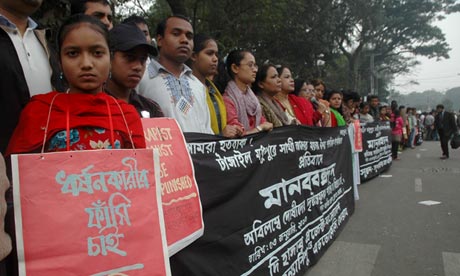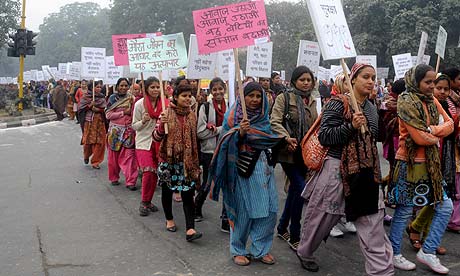Shashi Tharoor’s proposal to name the anti-rape law after the Delhi gang rape victim, if and only if her family agrees, has sparked a bit of a row. Tharoor wonders in his tweet “what interest is served by continuing anonymity of #DelhGangRape victim.”
Now that the family has said it has no objection, the other question to ask is what interest is served by naming a law after her.
Kiran Bedi, in supporting Tharoor’s idea, tweeted “This has been done in USA: Brady, Megan, Karly, Jessica Law etc…”
She is right of course. Megan’s Law is named after a little girl who was assaulted and killed by a sex offender who lived across the street. Megan’s parents had been clueless. Brady’s law for handgun checks is named after Ronald Reagan’s press secretary who was permanently injured in the assassination attempt on the president in 1981. Karly’s law in Oregon helps children remembers a three-year old who died after allegations of abuse went unchecked.
There are plenty of others. Some are named after the famous such as the Lindbergh Law after the abduction of Charles Lindbergh’s son or the Donda West law after Kanye West’s mother who died after her plastic surgery. Some are named after ordinary people who became famous as victims – Matthew Shepard, the Wyoming college student who was tortured and left tied to a fence in the middle of the countryside. Or Ryan White who became a poster child for HIV discrimination when he was kicked out of school because of his infection. There’s even a law named after a cat – Buster’s Law about animal cruelty remembers a cat that was doused in kerosene and set on fire by a hoodlum.
Sometimes the name of a law honours the lawmaker but mostly it’s about memorializing the victim. In that sense Tharoor’s suggestion is entirely on the mark. This was a victim whose plight really galvanized the country. She was not a special case but she became a tipping point. Enshrining her name in the law would force a public with a notoriously short attention span to remember why this law was urgently needed. Tharoor’s proposal is radical, perhaps in ways he did not intend. In a country where naming things after people is usually an exercise in sugary sycophancy (Indira Gandhi this and Rajiv Gandhi that), finally a politician is recognising a very ordinary person, a victim.
But the real motivation behind the spate of laws named after victims in the US is much cloudier than just honouring their struggle. Sometimes it’s because that victim is regarded as the final straw in a festering problem. But as Andrew Karmen writes in his book Crime Victims: An Introduction to Victimology, it’s also often motivated by politicians who want to capitalize on national outrage to build support for a piece of legislation and also advance their careers. Changing a law or making one is a messy business and bound to attract opposition. But by attaching a name (and thus a personal story) to a law, lawmakers know that “the strong feelings evoked by a recent tragedy make it difficult for opponents to question the wisdom of implementing the reforms proposed in the name of the victim”.
Victimologists warn that you first need to see whether the law would actually help someone else harmed in that particular manner. For example, in the Mathew Shepard case, his killers had not been charged with a hate crime because neither Wyoming nor the federal government recognized sexual orientation as a reason for hate crimes. The fight to allow that to happen was a long and bitter one. It needed a face. Shepard died in 1998. President Obama signed the law finally in 2009. In that decade it helped to have a name that would keep reminding activists that the cause for which they were fighting was not a hypothetical one. It was real. It had left a young man so pistol-whipped, and battered that the cyclist who discovered him thought he was a scarecrow.
In other cases, naming a law after a victim is a way to change perception of an issue. Until young Ryan White came along, AIDS was regarded as largely a gay male disease. The plight of the hemophiliac White helped soften the opposition to funding for a disease that had been regarded by conservatives as the wages of sin.
In some sense that’s at work here as well. No politician will want to name an anti-rape law after a sex worker who was raped and killed. The Delhi gang rape victim is the perfect innocent victim for a crime where authorities usually aren’t shy about blaming the victim for the way she dressed, the drinks she had had or the men she was consorting with. Kiran Bedi tweets that naming her could help “remove the stigma” of rape. But the stigma of rape is much too real and the price of naming is borne by the victim and the family not activists like Bedi. Ten years after she went public with a brutal assault on her in a government hospital a destitute woman in Kerala regrets it.
I lost out on life. I think I should not have complained against the rape. The incident left me and my father isolated. Since then, not a single relative has visited us. Their attitude has ensured that I am stuck with the stigma of being a rape victim.In this case the family has come out and said that they would be honoured if the anti-rape law was named after the victim. That should end the privacy argument right there. And more power to them.
But the bigger fear is that the name of the law, and the hoopla around the act of naming, could trump its content. No one knows yet what is actually going to be in this law, what loophole it will plug, whether whatever shape it takes would have actually helped a woman like the one who boarded that bus that December evening.
BJP spokesperson Shahnawaz Hussain makes a lot of sense when he says, “This is the time for making a strong law against rape without any delay. Naming or keeping the victim’s identity a secret is not the main issue here.” Is our biggest problem even the lack of a “strong law” against rape or the fact that we have a law enforcement that does not take the existing laws seriously enough?
Tharoor says he wants to name the law after the victim because she was “a human being w/a name, not just a symbol.” But as a society we are terribly susceptible to the power of symbolism and naming a law after the woman could ironically be the ultimate act in empty symbolism.
“I want to live,” the young woman had told her mother.
Let’s get a law that’s worthy of her fierce struggle to live first. We can worry about its name later



